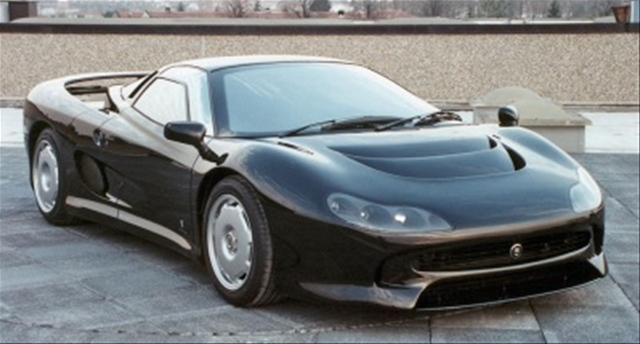The production version of the car was first shown to the public in October 1991 after undergoing significant changes. The most obvious of which was a completely different drivetrain and the elimination of the scissor doors. TWR was charged with producing the car and had several goals/rules: the car would be rear wheel drive instead of all wheel drive; would have a turbocharged V6 engine instead of the big V12; and performance goals of over 200 mph (320 km/h), 0 to 60 mph (97 km/h) in 3.8 seconds, and the lightest weight possible.
The 6.2 L V12 had been judged too difficult to get past increasingly strict emission regulations, and there were also reportedly some design problems caused by the size of the power plant. It was replaced with a Tom Walkinshaw-developed 3.5 L V6 based on the engine used in the Austin Metro 6R4 rally car and fitted with twin Garrett T3 turbochargers, generating 542 bhp (404 kW; 550 PS) of maximum power at 7000 rpm and 476 lb·ft (645 N·m) of torque at 4500 rpm. This engine was the first V6 in Jaguar's history, and was the first to use forced induction. In spite of the smaller displacement and half the number of cylinders, the engine produced more power than the V12 would have. However, potential customers judged the exhaust note to be harsh and the lag from the turbos to be an annoyance. Also missing from the production version of the car was the Ferguson all wheel drive – the production car had only rear driven wheels, through a conventional transaxle – and the ABS.
View of the XJ220 from behind
The car entered production in 1992 in a purpose built factory at Bloxham near Banbury, and the first cars were delivered to customers in July. Original customers included Elton John and the Sultan of Brunei.
Many of the initial customers were dissatisfied not only with the modifications to the original specification but the significant increase in delivery price from the original £361,000 to £403,000 ($650,000 USD). Another blow to potential sales was a global recession which took hold between the car's original announcement and its eventual release. This caused many original speculators to not want to buy the car, either because they were no longer able, or because they did not think they could sell it on. Further complicating the issue was Tom Walkinshaw's offer of the faster (by acceleration, not top speed), more expensive and more exclusive XJR-15 which was based on the Le Mans champion XJR-9. Some customers reportedly either sued Jaguar or threatened to sue; in any case, Jaguar gave the customers the option to buy themselves out of the delivery contract. As a result, many of the owners challenged Jaguar in court where the Judge eventually sided with Jaguar. To reduce costs the use of parts from mass production cars had been extensive; for example the rear view mirrors came from the Citroën CX 2 Series.
In spite of the drama surrounding its creation, a total of 281 cars were made and by 1997, few of these remained available for sale new at £150,000. Nowadays, it remains a sought-after collectible sports car, fetching £100,000+.The XJ220 is not only the fastest but the widest car Jaguar has ever built at nearly 7 feet in width.
Subscribe to:
Post Comments (Atom)





0 comments:
Post a Comment